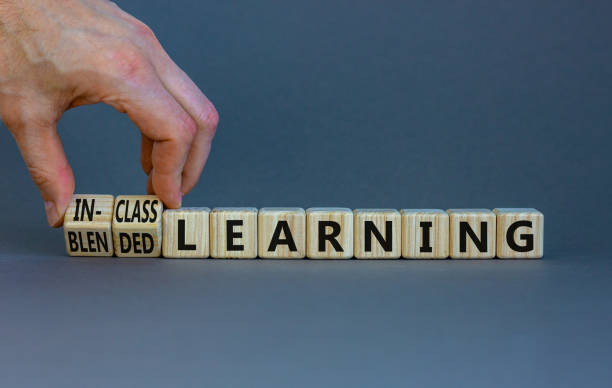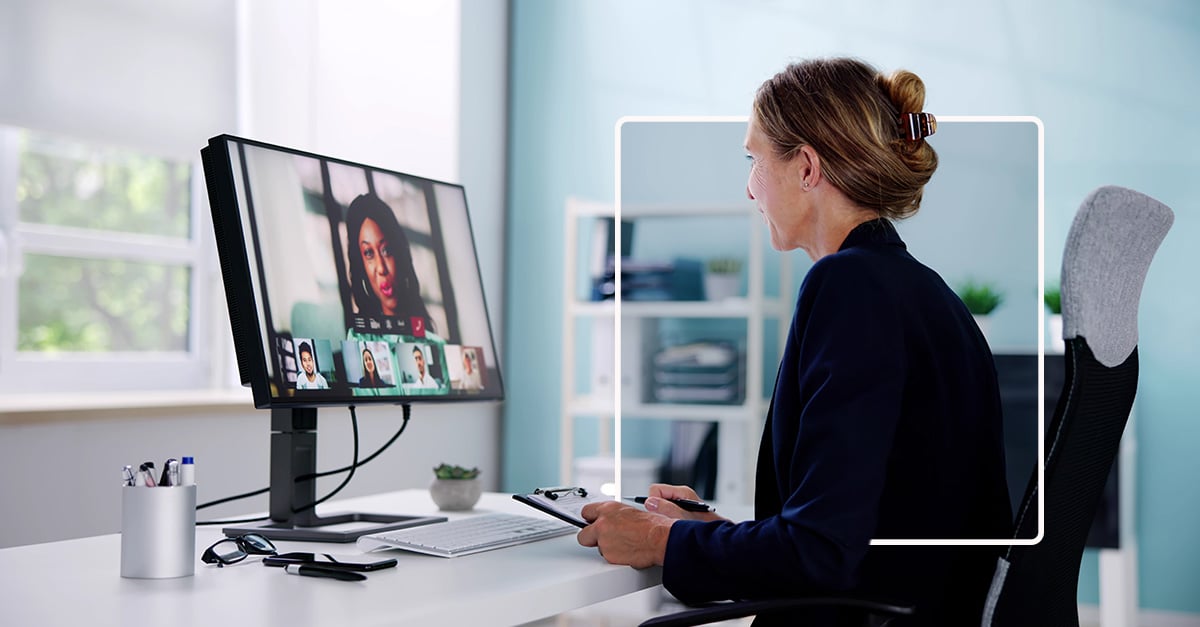7 min read
Blurring Lines: The Future of Blended Learning Design in a Hybrid World
 Jennifer Hofmann
:
Jun 12, 2024 2:00:00 PM
Jennifer Hofmann
:
Jun 12, 2024 2:00:00 PM

Focusing on Outcomes Instead of Technology Shifts the Focus to Solving Business Problems
Don’t Blame the Messenger
In an era when the digital transformation of learning and development (L&D) is not just an advantage but a necessity, it's easy to find ourselves focused on the wrong thing—technology. When training initiatives don’t work as planned, our instinctive reaction often is to blame the technology for the shortcomings of an entire program. This knee-jerk reaction, however, misses the point.
Effective learning design isn't based on the sophistication of the technology but on the clarity of the message it conveys and the experiences it fosters. Our focus on how it’s delivered—be it virtual classrooms, webinars, or e-learning platforms—risks overshadowing the essence of what we aim to accomplish. We muddy the waters by elevating instructional delivery technologies over the core objectives of the learning experience and outcomes it intends to achieve.
It’s challenging! Learning professionals need to create blended learning journeys that not only accommodate hybrid work environments but do so with a focus on aligning learner needs with business goals. By crafting these journeys thoughtfully, we can ensure that the outcome resonates on both an individual and organizational level. In navigating the future of blended learning design within this hybrid world, our focus should not be new technology but the desired results—creating learning solutions that address real business problems while enriching the learner's experience.
Beyond Labels—Rethinking the Delivery of Learning
Learning and Development (L&D) has so many tools and methodologies at its disposal. From eLearning to microlearning, virtual classrooms to augmented reality, the spectrum of instructional technologies is broad and varied. Traditionally, we've leaned heavily on these distinctions, labeling each piece of content by its delivery mechanism. However, these labels are increasingly losing their relevance to the very people they are designed to serve—the learning audience.
The truth is learners, managers, and even training professionals come with preconceived notions about the effectiveness of various learning modalities. Virtual learning is often dismissed as ineffective, webinars are labeled boring, and eLearning is criticized for being nothing more than a series of clicks that fail to engage. Conversely, face-to-face learning is frequently touted as the gold standard. These opinions, while widespread, don't necessarily reflect the potential for success across all formats. There are many examples where each of these methods has been applied with great impact.
The disconnect stems from an overemphasis on the "how" of teaching, rather than the "what" and the "why." The distinctions between learning technologies speak volumes about the medium but little about the message or the mission behind it.
What if we shifted our focus? Imagine a scenario where the conversation is no longer about the vehicle of learning but about the end result. Instead of categorizing initiatives as eLearning or webinar sessions, we align them directly with the learning outcomes they’re designed to achieve and, crucially, tie these outcomes explicitly to business goals.
By reframing the discussion, we pave the way for a more effective L&D strategy—one that’s not bogged down by technological classifications but is focused on what truly matters: imparting knowledge and skills that resonate with learners and drive tangible business results. It’s time to get beyond technology labels and have a more meaningful focus on learning design. By doing so, we not only enhance the learner experience but also reinforce the strategic value of L&D within the organization.
In essence, the future of blended learning design in a hybrid world lies not in the tools we use but in the clarity of our intentions and the strength of our outcomes. It's about understanding and addressing the needs of our learners, all while keeping an eye on the objectives of the business. This alignment should be the path for L&D, guiding us through the complexities of modern educational technologies toward the important goal of effective learning.
Maximizing Engagement in Hybrid Learning with Blended Learning Design
Today, the concept of hybrid learning environments has become a pivotal aspect of training design. But how does this approach work within the framework of blended learning design? To unpack this, we first need to understand what blended learning entails—it's a comprehensive approach that encompasses both the delivery technology and the content. This method integrates live classes, which can be either in-person, virtual instructor-led, or a mix, alongside a range of self-paced activities and resources.
It’s critical to acknowledge that learning content rarely exists in isolation. Even materials designed to stand alone contribute to a broader educational ecosystem, each element important in a learner's development. However, the term "blended learning" often speaks more to L&D professionals than it does to the learning audience itself. For learners, the structure and labels are secondary to the learning experience and outcomes. It's more intuitive and beneficial to think of blended learning as a "program" or "learning journey."
With the advent of the hybrid workplace, designing effective blended learning experiences has become more crucial than ever. Such environments need to stimulate intellectual engagement and curiosity, catering to the diverse needs and contexts of learners. The hybrid learning model is fundamentally about understanding and adapting to the learner's environment—where they are and how they interact with the content—and accommodating the variety of contexts in which learning occurs. This recognition is key to fostering an inclusive and engaging learning environment.
In the modern workplace, where individuals might be working from home, the office, or elsewhere, at different times, through various mediums, our learning programs must embody both hybrid and blended elements. They must be agile and flexible, able to cater to the diverse lifestyles and learning preferences of today’s workforce. Yet, despite the importance of these concepts to the design and development process, it’s essential to remember that learners are less concerned with the labels "blended" or "hybrid." Their focus lies on the relevance, accessibility, and effectiveness of the learning experience.
Therefore, as we move forward, the challenge for L&D professionals is not just about incorporating hybrid and blended learning principles into their designs. It's about transcending the jargon and focusing on creating meaningful, impactful learning journeys. By doing so, we not only enhance the learners' experience but also align these programs more closely with the evolving needs of the business and its workforce. In this way, we ensure that our educational initiatives are not just keeping pace with the changing landscape but are actively leading the charge toward a more dynamic, responsive approach to development and growth.
Distinctions that Matter: Instructional Strategies, Techniques, and Technologies
In the quest to craft compelling and effective blended learning experiences, appreciating the nuanced differences between instructional strategies, techniques, and technologies is paramount. These elements, while interrelated, serve distinct functions in the educational design process, and their thoughtful integration is what propels learners toward achieving their objectives.
- Instructional Strategies form the backbone of any learning program. They define the overarching approach to be employed, setting the stage for the detailed planning that will follow. An instructional strategy answers the critical question of how to structure learning to facilitate the desired level of mastery. This might involve adopting task-based, game-based, social collaborative, problem-based, project-based, inquiry-based, or case-based learning, among others. Each of these strategies offers a unique path to knowledge acquisition and skill development, emphasizing different aspects of the learning process to suit various objectives.
- Instructional Techniques are the actual methods through which the chosen strategy is executed. Think of them as the vehicles that carry learners along the path laid out by the strategy. Whether it's through lectures, brainstorming sessions, simulations, gamification, case studies, or moderated discussions, each technique has the potential to facilitate progress toward the learning goals. These techniques are often interchangeable, with the choice depending on the specific context and learner needs, yet they all share the common aim of enriching the learning experience.
- Instructional Technologies refer to the digital tools and resources that support and enhance the learning process. From e-learning platforms to virtual reality systems, these technologies offer diverse ways to deliver content, foster interaction, and assess progress. The selection of technologies is guided by several factors, including the learning objectives, the environment in which learners will apply their skills, and the need for authentic learning experiences. Categories of technologies include tools that support knowledge distribution, communication, social interaction, assessment, immersive experiences, and content curation.
Understanding these distinctions enables training professionals to tailor their design approach more effectively, ensuring that each component of the learning experience is aligned with the learners' needs. It's the combination of strategies, techniques, and technologies that culminates in a successful instructional outcome. By focusing on the synergies between these elements, educators can create a blended learning environment that offers the best opportunities for learner engagement and achievement.
Ultimately, while the distinctions between strategies, techniques, and technologies are vital from a design perspective, they fade into the background from the learner's viewpoint. To them, the importance lies not in the categorization of their learning experience but in its effectiveness and relevance. The art and science of instructional design lie in merging these distinct elements into a seamless whole, presenting learners with a cohesive and impactful educational journey. In the end, it's all just learning—but understanding the nuances behind the scenes is what creates the most resonant learning adventures.
Aligning Learner Needs with Business Goals
A pivotal aspect of designing effective blended learning experiences lies in the alignment between learner needs and business goals—a principle that calls for a clear-eyed focus on the end objectives from the outset. Understanding what the business aims to achieve is the first step in this alignment process. From there, identifying what employees need to learn or improve upon to meet these business objectives becomes crucial.
In today’s global economy, this alignment also necessitates a design approach that embraces inclusivity across cultures. The richness of diverse perspectives can significantly enhance the learning experience, but only if the content and delivery are accessible and relevant to individuals from various cultural backgrounds. This means considering not just the linguistic differences, but also the cultural nuances that might affect how learning materials are perceived and understood. By weaving these considerations into the fabric of blended learning programs, businesses can ensure a more comprehensive and inclusive approach that benefits all participants.
Moving Forward
The landscape of workplace training is forever evolving, with blended learning emerging as a linchpin in the hybrid work environment. It's a methodology that, when executed effectively, offers a flexible, inclusive, and comprehensive learning experience, tailor-made to meet the divergent needs of today’s workforce. However, the true potential of blended learning is unlocked not through an overemphasis on its technological underpinnings but through a steadfast focus on outcomes.
By centering our design and development strategies on the desired outcomes—what the business needs to achieve and what employees need to learn to support those goals—we pave the way for more meaningful and impactful learning experiences. This outcome-focused approach ensures that the value of learning initiatives is immediately apparent, not just to the individuals who participate in them but to the organization as a whole.
The future of training in the hybrid workplace depends on our ability to blend various elements of learning—be it through strategies, techniques, or technologies—into a cohesive whole that resonates with learners and aligns with business objectives. As we forge ahead, the emphasis must remain on creating holistic learning journeys. These journeys should not only adapt to the changing dynamics of the workplace but also contribute tangibly to individual growth and organizational success. In doing so, we affirm the intrinsic value of blended learning, not just as a method of content delivery but as a vital instrument for achieving broader business aims and fostering a culture of continuous learning and development.
Ready to Transform Virtual Learning?
Book Your Free 30-Minute Planning Session Now
In just 30 minutes, we can lay the groundwork for your program's success. Our complimentary planning session offers
- Tailored Insights: Understand how our solution can be meticulously adapted to meet your organization's unique needs and challenges.
- Actionable Steps: Together, we'll map out the path to your training program's success, setting immediate and impactful goals.
Don't miss this opportunity to elevate your training approach with our unmatched virtual learning formula. Contact us now to schedule your Essential Starter Bundle 30-Minute Planning Session, and take the first step toward achieving your company’s learning and development goals.

Evaluating and Assessing Modern Blended Learning Outcomes
In discussing the concept of “blended learning,” we have previously stated that “modern blended learning is selecting the most appropriate delivery...

With Hybrid Learning, the 5 Moments of Need® Are More Important than Ever
Thanks Conrad and Bob! Read to the end for some personal advice on how to apply this approach from Bob Mosher
